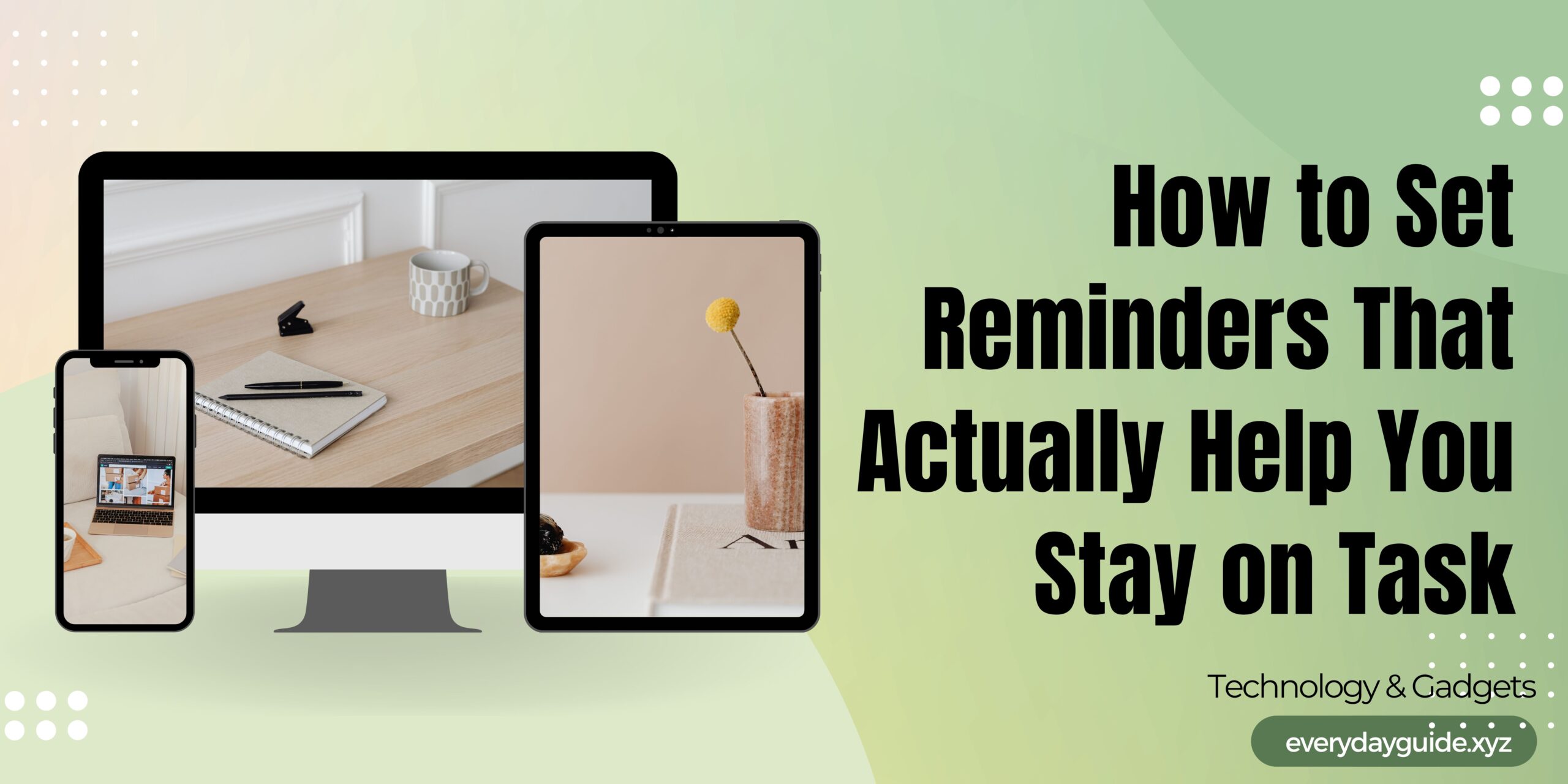Our world is moving fast and it can be difficult to stay organized with the many tasks we have at any given time. We are overworked, and with so many things competing for our attention almost daily it is easy to forget even the most important tasks. Enter, effective reminders — a combination of the right tools and strategic planning plus some psychological insights to keep you on track. What this guide will coverRecord reminders which are not only in your face but also capable of making you take the action. With advanced tech and an understanding of the psychology behind our most productive habits, we will explore the realm of task management and time optimization. After this article, you are going to learn all the tips & tricks that my friend has shared with me and how you can turn your reminder system into a competitive advantage in productivity & life.
The Psychological Theory of Successful Reminders

In the next post we will delve into many of psychological principles and understanding that underpin the art of setting a reminder effectively — those that keep you on task. It possible not all reminders will work the same way for every person since our brains are complex organs and how we absorb or act upon information will vary.
The first that I want to cover under the domain of psychology is the principle of salience. A salient stimulus is one that stands out in various ways from the background and draws our attention. With reminders — the salience should be unmissable push notifications. For example, that could look like unique sounds, vibrations or light signals disrupting the busy-ness of our day-to-day. Salience is what causes some things to demand our attention, and by understanding it we can create reminders that claim back our focus and improve the odds of completing a task.
Intrinsic motivation It is a significant psychological factor. Studies show that we are more likely to complete a task when we are internally inspired than externally pressured. Placing a frame of reference that is linked to our goals and values definitely helps elevate the reminders we set. Instead of listing out a task, I add a line that says why the task is important to me or how it fits in line with my long term goals. By using this approach, you will usually tap into your intrinsic motivation and as a result, you are more likely to not only notice the reminder but to take some sort of action on it.
Selecting the Right Tools and Technologies for Reminders
We are living in a digital age, where we have many tools and technologies for creating homework reminders. There are two work tools in particular which I mentioned earlier and combining them well makes a huge difference to being able to complete a task. These are some of the most powerful and functional alternatives.
Also Read More:
- 5 Mistakes That Are Costing You Money
 It is these small mistakes that can add up in time to amount to huge sums, and this is why being more careful with your personal finance is the key to long-term success. This blog is about, 5 Financial Mistakes Most… Read more: 5 Mistakes That Are Costing You Money
It is these small mistakes that can add up in time to amount to huge sums, and this is why being more careful with your personal finance is the key to long-term success. This blog is about, 5 Financial Mistakes Most… Read more: 5 Mistakes That Are Costing You Money - 7 Easy Ways to Save Money on Your Daily Commute
 Getting to and from work or school every day can eat a huge chunk of your budget without even realizing it. Thankfully, there are several simple money saving techniques you might have overlooked while driving to work every day. Whether that… Read more: 7 Easy Ways to Save Money on Your Daily Commute
Getting to and from work or school every day can eat a huge chunk of your budget without even realizing it. Thankfully, there are several simple money saving techniques you might have overlooked while driving to work every day. Whether that… Read more: 7 Easy Ways to Save Money on Your Daily Commute - 7 Tips for Saving Money While Shopping Online
 It is the era of digitalization and shopping online has now turned into an instant process to get desired things. Online shopping is great in terms of convenience but it has its downsides as well, mainly the case of overspending. Look… Read more: 7 Tips for Saving Money While Shopping Online
It is the era of digitalization and shopping online has now turned into an instant process to get desired things. Online shopping is great in terms of convenience but it has its downsides as well, mainly the case of overspending. Look… Read more: 7 Tips for Saving Money While Shopping Online - How to Cut Your Grocery Bill in Half
 Estimating your home grocery bill can be challenging with changing food prices and varying household requirements. Well, if you’ve been looking for some actual ways to slash your grocery bill in half… this is the post for you. To facilitate and… Read more: How to Cut Your Grocery Bill in Half
Estimating your home grocery bill can be challenging with changing food prices and varying household requirements. Well, if you’ve been looking for some actual ways to slash your grocery bill in half… this is the post for you. To facilitate and… Read more: How to Cut Your Grocery Bill in Half - 8 Easy Decluttering Tips for Busy People
 With today being so fast paced clutter can creep in as a creeping vine, making it difficult to be organized and focused. When you are a busy person, clutter can seem daunting to deal with but it need not be so.… Read more: 8 Easy Decluttering Tips for Busy People
With today being so fast paced clutter can creep in as a creeping vine, making it difficult to be organized and focused. When you are a busy person, clutter can seem daunting to deal with but it need not be so.… Read more: 8 Easy Decluttering Tips for Busy People
Your Own Personal Productivity Assistant: Smartphone Apps

The smartphone apps are probably the most familiar to everyone and (probably) widely used method to set reminders. Google Keep has an excellent user interface; it should be there in the list of every to do application with Apple Reminders as well and Windows App Microsoft To-Do Plus, you can set reminders for exact dates and times as well as choose a repeat pattern with these apps. They will also give you location-based reminders and keep track of where else you need to be. That could be handy for things that are related to places, such as “Remind me to buy milk when you walk past the supermarket”.
Ambient Reminders for Your Home aided eye ball tracking workstations WakunagaエスキンG Aqua Splash Mask…medium.com
Amazon Echo, Google Home or Apple HomePod type devices can work brilliantly as a reminder tool but are more suited for tasks that can be completed from anywhere so you do not sacrifice location specificity. Set reminders using voice: Remindees is facilitated with several devices for you to use, here you can Enable ‘Google Assistant’, Here also you can ask to remind time and other Yo! They can also serve as ambient reminders that gently remind you about tasks without forcing you to check your phone or computer.
Wearable: Quick Wrist Reminders
Nowadays you can set up reminders on smartwatches and fitness trackers. Wrist devices (such as the Apple Watch or Fitbit) to send haptic notifications — a little buzz on your wrist. This is particularly handy for timely reminders or in situations where checking your phone may be difficult or inappropriate. A lot of these devices also sync or come with health and fitness apps built in where you can make specific reminders for workouts or meditations.
Writing Good Reminder Messages
An important factor that influences how effective your reminder messages are is in the content and structure of them. A good reminder may encourage you to do something, whereas a bad one may be ignored completely or forgotten. The following are some of the strategies one needs to keep in mind while creating reminder messages that can actually help oneself in time:
Get to the Point and Be Actionable
A general message is harder to commit to memory or act in response to. Rather than creating a reminder that says, “Work on project,” get specific, such as “Write the intro for marketing report. The more accurate your reminder is, the more straightforward the next step to take. By breaking things down, you help users have less friction to get started and are therefore more likely to click through.
Provide Context and Reasoning
Including the context and background of sticky notes in your reminders makes them much more effective. Add context about the task—why is this important, what happens if we dont do it? For instance, instead of “Call John” you can write a reminder as “Call John for budget numbers plan ahead meeting tomorrow” It just provides more context that the task maybe little bit important and will make you do it faster.
Use Time-Based Language
Adding time-bound words in your reminders will make you more specific and will help you to better organize your day. For example, instead of setting a reminder for “2:00 PM,” set it to read “Start project outline in 30 min”. You are prepared to do the task when your mind is on it and gives you time in case you are doing something else when the reminder pops up.
How to Set Up Your Reminder System for Peak Productivity

Tools and reminder messages are great, but the thing to prevent the most of these is a solid one: a reminder system. Taking a systematic, well-organized approach to reminders can save you time and headaches, helping you be more mindful of your schedule in the near future while keeping you from missing out on important tasks. Now, we will learn a few techniques to build an effective reminder system:
Categorize Your Reminders
Different categories for your reminders can help you to easily see what needs to be done first. These are just common categories:
- Work-related tasks
- Personal errands
- Health and fitness
- Social commitments
- Long-term goals
- You can work on these categories whenever you think that your balance task management is getting imbalanced.
- Implement a Priority System
- Some tasks are more equal than others, and your reminder system should respect this. You could also have a priority system like this:
- Definition of a high priority: things need to be done asap (Franke, no date)
- Medium: Tasks which are essential but not immediate
- Low priority — Just the items that if you could complete would be amazing but nothing holding your work back at this point.
- Your chosen reminder app allows you to use colors or symbols (or tags if available) to visually represent the priority. It helps you triage which tasks are the most important and need to be resolved first when 3 new messages come in at once.
Use Time Blocking
Note that time blocking refers scheduling out specified blocks of time in your workday for only certain types of tasks or activities. Add it to your reminder system, enabling reminders not only on individual tasks but these work blocks. For example:
- 9 to 11 a.m. — Deep work on project Y
- 1:00 PM — 4:00 PM: Work Would need Overtime 5:00 PM -Respond to Emails
- 1:00 -2:00 pm Team meeting
- 2:00-4:00 PM – Call client
Having your reminders set up in time blocks helps you establish a schedule that works for you, which will keep you glued to your tasks without having to switch between them too much.
Advanced Reminder Procedures that Assist in Maintaining you Engaged
If you get a good understanding of easy memory improvement first, then you can add some of the more advanced ones to really step up your productivity and task management. Implementing these approaches will allow you to produce a more dynamic set of reminders which adjusts based on your evolving needs and situations.
Contextual Reminders
Contextual reminders uses the current place and time trigger to provide more appropriate, useful notifications. This functionality is now supported by many smartphone apps and Smart Home devices. How To Set Contextual Reminders
Geo-reminders: Get notifications when you enter or leave an address. One use case might be to deliver a reminder to purchase milk when you enter your local grocery store
When reminders go off: Have reminders only activate at certain times during the day (i.e., work-related ones might be limited to popping up after you get in the office).
Need-based reminders: Pull in data from fitness tracker or smartphone to suggest reminders based on what you are currently doing. One example might be a reminder to stand up and stretch after you any been sitting too long.
Weather-activated reminders: Some super advanced apps let you set weather-based triggers for your reminders. This has the utilities like water, or other small work like bringing your outdoor furniture in case of a storm.
Progressive Reminders
Progressive, on the other hand it refers to a series of increasingly insistent notifications for important todos. This can be especially useful for tasks that are coming up soon or which you need to prepare for. First, let me cover the progressive reminder implementation:
- First follow-up: A friendly reminder, one week before a task fell due
- A larger reminder three days before the due date
- Final call: A last minute alert on the eve of closing date
- Last Chance: Inseparable “Task Due Today” alert
- This way you will not end up rushing right from the start and plan your time better.
- Habit-Forming Reminders
Use a dedicated habit-tracking app or feature for items you think have the potential to become repeated tasks. These tools are built using concepts taken from behavioural psychology to create habits. Key features might include:
Habit Streak Tracking: Mapping out your progress helps motivate you to keep a routine.
Incremental Growth — Begin with few easy goals and grow the amount of time you do that particular thing.
Use positive reinforcement: Cover ways to reward yourself or celebrate each milestone as you move through the habit forming process.
Using these advanced methods, you can develop a more intelligent list of reminders that ensures you complete what needs to be done while nurturing your long-term objectives and empowering your internal development.
Common Reminder Mistakes Suggested mistakes and ideas to prevent them
These are the most common challenges that can affect how well your reminder system helps even with you being equipped with best intentions and tools. Understanding and fixing these traps is necessary to keep an efficient and stress-free method of task management going. Here are some of the most common concerns and how to address them:
Reminder Overload
More often than not, people will set too much of a good thing leading to notifications alerts that just accumulate in the list — and either get ignored or dismissed. This “alert fatigue” could devalue the power of your reminder system.
To combat reminder overload:
5- Review your reminders: Regularly check out what you have in your reminders and delete whatever it is that you no longer need or lack relevance to.
Group similar tasks: Instead of keeping reminders differently together similar tasks in a single comprehensive reminder.
Follow the 2-minute rule: over anything that would possibly be accomplished in less than 2 minutes, do it now as an alternative to setting reminders for yourselves.
Prioritize Cock Related: Be real with yourself about which tasks ACTUALLY need reminders and could be managed by a simple to-do list instead.
Procrastination and Avoidance
Whether well-executed reminders succeed over procrastination or task-avoidance often depends on other factors. It might be because of other deeper issues such as fear of failure, perfectionism or simply not enough motivation.
To address procrastination:
Divide intimidating tasks into smaller steps: create reminders to achieve these small objectives rather than a massive task.
Another way is to employ the 5-minute rule: when a reminder goes off, just commit to working on that task for 5 minutes. More often than not, this is just the push you need to overcome initial resistance and get into some real flow.
Reward yourself with unpleasant tasks: Create a new reminder that combines the task and reward, such as “Complete your expenses for 15 minutes.middleware then spend 15 minutes break”.
Get to the cause: If procrastination continues to be a challenge, it maybe a larger issue and requires the assistance of a coach or therapist.
Reminder Dependency
In some cases, however, relying too heavily on reminders can compromise our natural abilities to remember and prioritize tasks. In the same vein, this reliance on a system is an issue if you start to struggle without having regular prompts from your reminder system.
For a happy medium:
Active Recall: Instead of immediately checking off the tasks on your app or bookmark (the latter making this not redundant), see if you can remember all of the tasks for today.hashing up a mental list actually counts as legitimate practice. This particular exercise can reinforce your memory but also wean you off of external prompts a bit.
Reminders are helpful but should be used as a back-up not a crutch: Fill separate buckets of your schedule with routine tasks that you repeat each week so that it becomes part of who you are and has stick when planning. Lean on your prompt system for only part of the time — otherwise using it as a backup.
Less is more: If you have been doing it, reduce the frequency. Improves your ability to take control of your responsibilities and become more independent.
Hold regular planning sessions -Take one-on-one time each week to assess and plan your tasks. By being proactive, this creates less need for an alert all throughout the week.
Avoid these pitfalls and you could develop a more balanced, productive reminder system that builds on your ability to deliver without making you stressed or dependent.
Using productivity methodologies in Reminders
For a more holistic approach to improving it, why not try to marry your reminder system with established productivity methodologies. Use these frameworks to organize, tie together your reminders and keep working towards the things you want instead of getting caught up only with what needs to be done at that very moment. In this post, I dive into how reminders can mix with a few common productivity practices:
The Getting Things Done (GTD) System
David Allen, proposes capturing everything in one place; then organizing it according to the action required for each task. How to incorporate reminders into GTD
Use as a Capture: Your reminder app should be pocket sized (i.e. your phone) and easily accessible on the go for you to quickly enter tasks or ideas as they occur to you.
Elaborate: send regular reminder alerts to go over your captures in you tracker and convert them to doable.
Set reminders: Use lists with labels or tags in your reminder app to categories tasks into GTD next actions, waiting for lists.notifyDataSetChanged list
Act: Use your GTD weekly review process, creating a reminder to check and update/revise task lists on at least a weekly basis.
Engage — Create reminders that are context-driven (location, time) to do specific next actions so you can knock them out when in those contexts.
The Pomodoro Technique
- The Pomodoro Technique is about working in 25 min focused intervals, then take short breaks. And include this into your reminder system:
- Schedule reminders to launch every Pomodoro so you maintain regular intervals of work.
- In your reminder app log all complete p Tom ors & set important reminders as milestones just to celebrate the process.
- Set alarms also for your longer breaks once you hit 4 pomodoros in order to remind you that it is time for a bit of rest.
- Put end-of-day reminders to look at how many Pomodoros you have done and to plan your work sessions for the next day.
The Eisenhower Matrix
This is a method for prioritizing tasks based on their urgency and importance. Include in your reminder notifications
Organize your tasks into these four quadrants in the tags or categories of your reminder app: Urgent and Important, Important but Not Urgent, Urgent but Not Important & Neither Urgent nor Important.
Do not receive the exactly same type of notifications, Do create different Types/Priorities- based on which will help you in following your types and then within 1/4 reminders only if it has come to an end.
Regular reminders to revisit and update your task quadrants in order to ensure you are working on what aligns with your goalsutils.
The PARA Method
He uses the PARA method defined by Tiago Forte to categorize information as Projects, Areas, Resources, and Archives. Change your system to have you set reminders in this manner.
- Set up Projects, Areas (Context) and Resources as folders or categories in your reminder app.
- In the Projects category, add reminders for project milestones and deadlines.
- Establish recurring reminders for weekly area of responsibility check-ins.
- Consider using reminders to trigger regular checks on your Resources and make sure you are putting the information you are collecting to use.
Conclusion
If you realize that different tasks are left incomplete, then try to organize your work with a particular deadline and make sure to save it somewhere and keep it, without piling them up into things of clutter.
With your reminder system fully integrated with these productivity methodologies, you have a much more robust and thoughtful task management approach. This integration makes your reminders more than just another noise signal, but part of a uniform voice to help yo ufocus on doing the most important things and BEING in alignment with what is most IMPORTANT.

